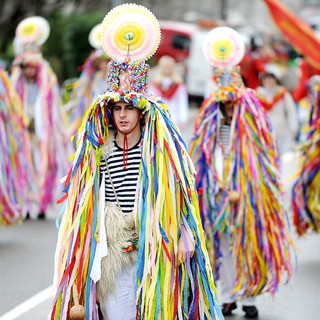From Rukavac to Bregi and Žejane - Bell Ringers and Carnival Foods
- Andrea Seifert

- Jan 30, 2017
- 3 min read
The wearing of masks, with which man performs fertility rites, drives away evil spirits and marks the passage of winter into spring, has been present in almost all civilizations and all parts of the world since times long past. This custom has particularly taken deep roots in the localities of the North Croatian Littoral, namely its backcountry – Kastavština.
In the course of the historical context of emergence of carnival customs in our region, various bell – ringer groups (zvončari) appeared. They became an inevitable part of the carnival ritual, not only in the Kvarner area, but wider. The bell-ringers mark the very beginning of the Carnival – hence the first bell-ringer bells make themselves heard in Mune and Žejane on Epiphany (6th January), and in the other localities on the Saint Anthony holiday (17th January).
Today we differentiate the bell-ringer groups of Rukavac, Zvoneće, Bregi, Brgud, Mučići, Žejane, Mune and Halubje. The distinctions between these groups are in pieces of garments they dress in, or in the characteristic bell-ringers’ gait and the additional elements they wear. However, they all wear white trousers (some with a red or blue stripe, though some wear jute trousers with sewn on ribbons) and sailor’s striped jerseys, sheepskins around the neck or waist, three bells or a single one respectively, head scarf or bandanna.

The bell-ringers of Rukavac, Bregi, Brgud, Mučići and Zvoneće wear hats with colorful crepe paper flower decorations, while the bell-ringers of Mune and Žejane wear hats with varicolored strips from the top of the hat to the ground. Only the Halubian bell-ringers wear large beast-like masks instead of hats. All the bell-ringer groups wore such masks until the beginning of the Italian occupation, when they were prohibited.
Mune and Žejane are quite specific in whole region not only because its inhabitants are descendants of Romanian Vlach population, but also of carnival traditions. When bell ringers come in a village, their leader first enters a home to greet the owner and only then all other bell ringers enter. They gather in their baskets eggs and money and on long sticks bits of bacon. Eggs and bacon are used for big omellette. Main difference between Žejanski zvončari and Munski zvončari is in the colours and styles of strips and hats. Žejane is also specific for using sour beet instead of sauerkraut, in a classic winter dish consisting of beans, dried meat, bacon, and garlic (Huverova repa). Fritule, which is fabourite winter dessert in the Adriatic, is made with yoghurt, which is again very unique.
Place of Rukavac has its special bell ringers’ association, Rukavački zvončari. They are known for their elaborate outfit, similar to Halubje bell ringers but without animal mask. Two places, Rukavac and Zvoneća have same bell ringers who are followed by partenjaki, boys and girls who walk around asking for gifts.
There is also a little devil, all in black but with red horns. You may try to run away from him, but he will find a way to make two black strips on your cheeks! In every time of year you can also see the Bell ringers’ Museum in Rukavac, but be sure to check with the Tourist Board if it is open.
All the restaurants, inns and taverns in the area offer something from our wide range of traditional dishes: turnip, pork loin, sauerkraut, home-made bread, sausages, pršut dry-cured ham, various sweets (supice, presnac, grašnjaki) and much more. The choice is yours, but we have visited the famed Stancija Kovačići.
Another very old bell ringers’ association is Brežanski zvončari from place of Bregi, high above Opatija. They have similar features to the Rukavački zvončari, but add with a very specific dish – olita or sweet blood sausage. The recipe is family heritage for more than 150 years, it is traditionally made only for the carnival season, although it is already rare to find. This blood sausage has addition of sugar, cloves, cinnamon, and raisins. It is indeed a very special thing to try!
Matulji Tourism Office:
Address: Trg maršala Tita 3, 51211 Matulji, County of Primorje-Gorski kotar, Croatia VAT ID (OIB): 60986406974 Telephone: +385 (0)51 276 789 Fax: +385 (0)51 276 221 E-mail: tzmatulji@tzmatulji.hr











Comments